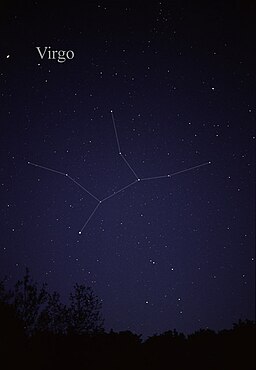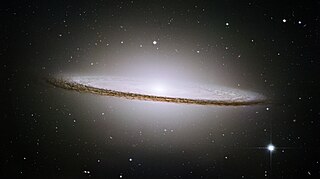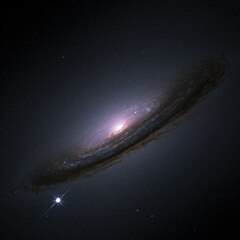Virgo (constellation)
Virgo (the virgin) is a constellation. It lies between Leo to the west and Libra to the east and is one of the largest constellations visible in the sky.
Virgo is often pictured carrying two sheaves of wheat, one of which is marked by the bright star Spike or Spica, the "spike" of medieval farmers. The location of Virgo is easy thanks to this star, which is found by following the curve that goes from "the car" (Osa Major) to Arturo (α Bootis) and continuing this curve until reaching Espiga.
Notable features
Spike (α Virginis), the brightest star in Virgo, is a binary system whose components are only 0.12 au apart with an orbital period of 4.0145 days. The main star has a spectral type B1 —classified as giant or subgiant— and a mass 11 times greater than the solar mass, being one of the closest stars to us with enough mass to end its life as a type II supernova.
Porrima (γ Virginis), the second brightest star, is also a binary composed of white stars of the main sequence of spectral type F0V and a surface temperature of 7100 K. The orbital period of the system is 169 years and the last periastral —minimum separation between components— took place in 2005. The remarkable eccentricity of the orbit makes the distance between both components oscillate between 5 and 81 AU. This stellar system is located 38.6 light years from Earth.
The third-brightest star in Virgo is ε Virginis, called Vindemiatrix, Protrigetrix, or Almuredin, a yellow giant of type G8III with a luminosity 83 times that of the Sun and a radius 11.4 times that of the Sun. solar. It has a metallicity—relative abundance of elements heavier than helium—approximately 30% higher than solar ([Fe/H] = +0.13). Next in brightness is Heze (ζ Virginis), a white main-sequence star accompanied by a faint red dwarf.
Another star to note is Zavijava (β Virginis), a yellow dwarf of type F9V 35.6 light-years from Earth. It has a temperature of 6059 K, about 280 K hotter than the Sun, and an iron content 30% higher than the Sun; with a mass between 30 and 40% greater than the solar mass, it is thought to be about to leave the main sequence. μ Virginis, known as Rijl al Awwa, is also a white-yellow main sequence star of type F2V, hotter (6715 K) and twice as luminous as Zavijava, located 61 light-years from Earth. Syrma, called ι Virginis, is a yellow subgiant of spectral type F7IV with a luminosity 9 times greater than that of the Sun. δ Virginis, whose official name is Minelauva, has very different characteristics, a red giant of type M3III with a diameter 61 times greater than that of the Sun and a bolometric luminosity —at all wavelengths— 630 times higher than the luminosity solar.
Among the constellation variables are the Mira R Virginis and RU Virginis variables. The apparent magnitude of the first varies between +6.1 and +12.1 in a period of 145.63 days, while the second does so between +9.0 and +14.2 in a period of 433.20 days. RU Virginis is also a carbon star whose spectrum presents the characteristic absorption lines of this element. Its surface temperature is only 2100 K and, like other similar stars, it loses stellar mass at a high rate.
Another Virgo variable, W Virginis, is an archetypal pulsating star of a class of variables called Population II Cepheids or W Virginis variables. FF Virginis, called Preston's Star, is an Alpha2 Canum Venaticorum variable of type ApEuSrCr whose spectrum shows strong chromium and strontium absorption lines and, as is characteristic of this class of variables, has a large magnetic field. CW Virginis, equally variable Alfa2 Canum Venaticorum, also presents very high contents of strontium, chromium and europium; in the case of the latter element, its relative abundance is up to 30,000 times higher than in the Sun.
Several Virgo stars have planetary systems. χ Virginis is an orange giant of type K2III with a metallicity greater than that of the Sun around which two exoplanets orbit. Likewise, 70 Virginis is a yellow dwarf evolved with a gas giant that is 7.5 times the mass of Jupiter. Another yellow dwarf in the constellation, 38 Virginis, also has a planet that moves in a nearly circular orbit 1.82 AU from the star. Likewise, HD 130322 —called Mönch according to the IAU— and HD 102195 —named Phlegetonte— are orange dwarfs that have a "hot Jupiter" type planet: Mönche's has an orbital period of 10.7 days and that of Phlegeton of only 4.11 days.
Another interesting star is 61 Virginis, a solar analogue of type G5V with a mass and radius slightly less than that of the Sun whose luminosity is equivalent to 78% of the solar luminosity. In 2009, the discovery of three extrasolar planets in orbit around this star, with masses between 5 and 25 times the mass of the Earth, was announced. All three planets orbit very close to the star; compared to our solar system, all three would move within the orbit of Venus.
The star in the closest constellation to Earth, at 10.9 light-years, is Ross 128, a red dwarf type M4V with a luminosity of about 0.029% of solar luminosity. In 2017 an extrasolar planet with a minimum mass 35% greater than Earth's was discovered orbiting 0.049 au from this star. Another nearby system, Wolf 424, consists of two red dwarf stars—even dimmer than Ross 128—whose orbital period is 16.2 years; this binary is located 14.3 light-years away. Somewhat further away, Gliese 486 is another red dwarf —type M3.5V— where a hot "super-Earth" has been discovered that is 2.81 times the mass of Earth and 31% larger in size.
The fact that in the direction of Virgo lies the cluster of galaxies called the Virgo Cluster—between 5° and 10° west of Vindemiatrix—makes it an especially rich region in galaxies. Eleven galaxies in the Messier catalog are located in the direction of Virgo. M49 is one of the brightest galaxies in the cluster and was the first to be discovered; contains nearly 6,000 globular clusters. M60 is one of the giant elliptical galaxies in the cluster and has a linear diameter of 120,000 light-years. However, the dominant galaxy in the cluster appears to be M87, also a giant elliptical galaxy and one of the most massive in the local universe with some 12,000 globular clusters; a notable feature of this galaxy is a giant "jet" of ejected gaseous material. from its galactic core. NGC 4216, another member of the cluster, has absorbed some of its satellite galaxies, and faint stellar streams can be observed extending thousands of light-years into its halo. Other galaxies in the cluster are the barred spiral M58, considered an anemic galaxy, and M61, in which at least six supernovae have been observed in the last hundred years.
The so-called Sombrero Galaxy (M104), located 31 million light-years away and not part of the Virgo Cluster, deserves special attention. It has a large, bright nucleus, an unusual central bulge, and a prominent dust lane in the galactic disk. From Earth it appears seen in profile, which gives it its characteristic "hat" appearance.
In Virgo is 3C 273, the brightest quasar in the sky (in the visible spectrum) and the first to be identified as such. It is one of the closest to Earth with a redshift z = 0.158, which is equivalent to a distance of 749 megaparsecs. It is also one of the most luminous quasars, with its absolute magnitude being −26.7.
Main Stars
- α Virginis (Spiga or Spica), the brightest constellation with apparent magnitude +1.0, is a spectroscopic binary star with the two components very close to each other.
- β Virginis (Zavijava or Zavijah), with magnitude 3,61 is a yellow dwarf warmer and brighter than the Sun distant 36 light years.
- γ Virginis (Porrima), the second most brilliant with magnitude 2.74 is also a binary star with both white stars practically equal. It's easy to solve with a telescope.
- δ Virginis (Minelauva, Minelava or Auva), giant red star of magnitude 3.39 and semi-regular variable.
- ε Virginis (Vindemiatrix or Almuredín), of magnitude 2,83 is a giant yellow star of spectral type G8III. It is located at a distance of 110 light years.
- γ Virginis (Heze), of magnitude 3,38, white star to 73 light years located very close to the celestial equator.
- η Virginis (Zaniah), of magnitude 3.89, a triple star system.
- θ Virginis, multiple star of magnitude 4,38.
- ι Virginis (Syrma), yellow subgiant of magnitude 4.07.
- λ Virginis, star system of magnitude 4,50 to 187 light years away.
- μ Virginis (Rijl al Awwa), of magnitude 3,90, white-yellow star of the main sequence to 61 light years.
- Virginis, red giant and semi-regular variable of average magnitude 4.04.
- ο Virginis, yellow giant listed as "leve" barium star.
- ρ Virginis, white star of magnitude 4,87 surrounded by a circum-stellar disc of dust.
- τ Virginis, white star of magnitude 4,24 that has a tenuous star companion.
- Virginis, orange giant with two extra-solar planets. One of them has a mass at least 11 times greater than that of Jupiter.
- Warning Virginis, red giant and irregular variable star whose magnitude ranges between 4.73 and 4.96.
- ω Virginis, also red and semi-regular variable.
- 17 Virginis, a binary star of magnitude 6,46 whose components are separated 20 seconds of arc.
- 59 Virginis and 61 Virginis, stars similar to the Sun; the second, of magnitude 4.74, has three extra-solar planets.
- 70 Virginis, star with an extrasolar or brown dwarf planet (70 Virginis b) in an eccentric orbit.
- 83 Virginis, yellow supergiant of magnitude 4,16.
- 109 Virginis, although it does not have Bayer's name, is the seventh most brilliant star of the constellation with magnitude 3.71.
- 110 Virginis, an orange giant of magnitude 4.40.
- R Virginis, variable star type Mira, with varying magnitude between 6.2 and 12 in a period of 145.64 days.
- W Virginis, cefeed variable that gives name to a type of variables (variables W Virginis).
- RU Virginis and SS Virginis, both carbon stars; the first is a long-term Mira variable (433 days) and the second is a semi-regular variable.
- BH Virginis, eclipsant binary and variable RS Canum Venaticorum whose two components are yellow dwarfs.
- CU Virginis and CW Virginis (78 Virginis), variables Alfa2 Canum Venaticorum of respective magnitudes 5,01 and 4,91.
- Ross 458 (DT Virginis), a system composed of two red dwarfs and an object that can be a brown dwarf.
- FF Virginis (Preton Star), star Ap of magnitude 7,12.
- GR Virginis and HT Virginis, both are contact binaries, systems where two stars share their outer layers.
- HW Virginis and NY Virginis, eclipsant binaries whose main component is a spectral type B hot subenana.
- PP Virginis, Ap star of rapid oscillations (roAp) of magnitude 8,30.
- HD 102195 and HD 130322, the two orange dwarfs and each one of them with a "Hot Jupiter" planet.
- HD 104304 (HR 4587), 5,54-fold subgiant with a red dwarf as a star companion.
- HD 107148, yellow dwarf with an extrasolate planet at 0.27 UA.
- HD 109930, orange dwarf with very high metallicity.
- HD 126053, solar analog older than the Sun of magnitude 6.30.
- Ross 128 (FI Virginis) and GL Virginis, both red dwarfs and bright stars; the first one is 10,91 light years from the Solar System and around it has been discovered an extrasolar planet, Ross 128 b.
- Wolf 424, star system composed of two red dwarfs especially tenuous in the vicinity of the solar system.
- Wolf 489, solitary white dwarf at 26.7 light years of the Earth.
- PSR B1257+12, post with three extra-solar planets.
Deep Sky Objects
There are over thirteen thousand galaxies scattered throughout Virgo and Berenice's Hair. The Virgo Cluster is a group of galaxies containing more than 2,000 members. It should be noted:
- The elliptical galaxy M49, the brightest of the Virgo Cluster. It was discovered by Charles Messier in February 1771. Like other giant elliptical galaxies it seems to possess in its center a supermassive black hole. It is currently interacting with the small irregular dwarf galaxy UGC 7636.
- The giant elliptical galaxy Virgo A (M87), one of the greatest known. It is the largest and brightest of the northern area of the Virgo Cluster, also with a supermassive black hole. It's one of the brightest radio sources in the sky.
- The coiled spiral galaxy M58 located 6.o west of Vindemiatrix (ε Virginis). It is an anemic galaxy with low star formation activity, mainly in the optical disk of the galaxy, and relatively little neutral hydrogen, also located within its disk and concentrated in grumes.
- Elliptical Galaxys M59 and M60, east of M58. M60 has a companion (NGC 4647) located north.
- Rehilete Galaxy (M61), intermediate spiral galaxy of the SABbc type, one of the largest members of the Virgo Cluster.
- In the center of the Virgo Cluster, two lenticular galaxies, M84 and M86, separated 17 arcmin.
- M90 spiral galaxy, with smooth and poorly defined arms without just distinctive features.
- At 1,2.o east of M87 is the small elliptical galaxy M89, whose shape is practically spherical.
- The spectacular Sombrero galaxy (M104), of magnitude 9,0, with its dark strip in the equator, does not actually belong to the Virgo Cluster. It is invisible to the naked eye but easily recognizable with small telescopes. Distant 31 million light years of the Earth, it is considered the brightest galaxy in a 10 mega-parsec radius.
- NGC 4216, spiral galaxy profile view, and NGC 4536, 4th northwest of Porrima (γ Virginis).
- Lenticular galaxies NGC 4526 and NGC 4984.
- NGC 4567 and NGC 4568, two spiral galaxies interacting.
- Abell 36, distant planetary nebula 780 light years.
- Quasar 3C273, of magnitude 13, to about 3000 million light years is the most distant object visible with most amateur telescopes.
Mythology
In Greek mythology, it is the representation of Astrea, daughter of Zeus and Themis, goddess of justice for men. She had been born a mortal and was placed on earth to administer justice and order. She lived with mortals during the Golden Age and the Silver Age, but when the Bronze Race, whom she detested, was born, she left the earth and ascended to heaven, where she settled near the constellation of the Cattle Dog (boots). She was one of the three Hours or Titans and the most notable among the virgin goddesses.
In another version it was said that it was Erigone, daughter of Icario. Other versions identified this constellation with Demeter, Isis, Atárgatis (one of the names of Derceto) and Tyque.
Contenido relacionado
Lupus (constellation)
Cepheus (constellation)
Aquila (constellation)







